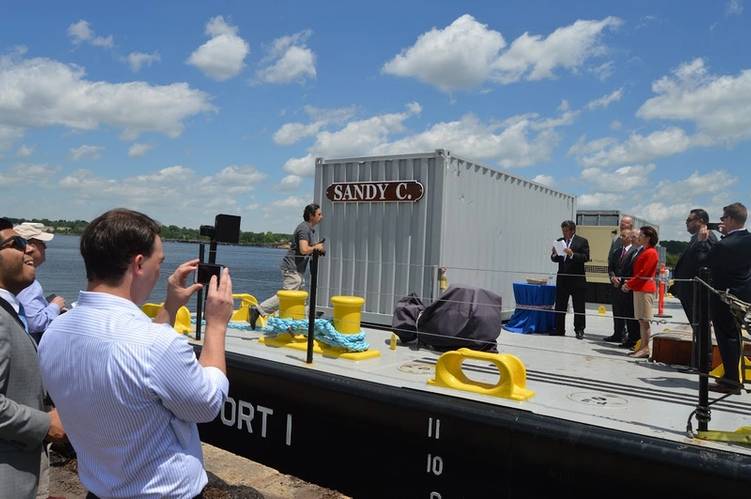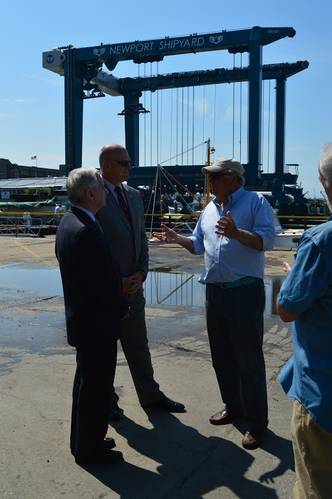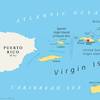When I visit Rhode Island, one of the first things I notice its extensive water resources available for tourism, sports and commerce not to mention the ability to move people from one place to another. Next, I think about the dynamic men and women working on and near the water in the maritime industries and businesses including ship construction and repair that support the State’s long-term economic prosperity. Boasting over 400 miles of coastline, it’s easy to see why maritime is a central part of the “Ocean State’s” heritage as well as the key to its economic future.
I saw this first-hand last week when I joined Senator Jack Reed and Governor Gina Raimondo, along with other state and local officials, to christen the Port of Providence’s latest asset, a new crane barge christened the SANDY C. Funded, in part, by a $10.5 million Transportation Investments Generating Economic Recovery (TIGER) grant, the Sandy C, along with two high performance mobile cranes delivered in 2013, are literally transforming the port into a modern marine cargo center.
A $22.3 million TIGER grant also figured prominently in the redevelopment of the Port of Davisville in Quonset, R.I., which I also visited. That port just experienced its sixth consecutive record breaking year for automobiles imported by ship. That grant, awarded in 2010, significantly contributed to the port’s success by supporting the purchase of a mobile harbor crane as well as terminal, road and rail improvements needed to increase the efficiency of the port and ability to handle higher volumes of freight and project cargo such as electrical power generating windmills.
Port projects like these are precisely what the Obama Administration had in mind when TIGER was created– transformative infrastructure projects that not only help shape this country’s future, but also open the floodgates of opportunity across this Nation. Since 2009, DOT’s TIGER Program has provided nearly $4.6 billion to 381 projects in all 50 states, the District of Columbia, and Puerto Rico –43 of those grants totaling nearly $524 million have been awarded to our Nation’s ports and other maritime projects, representing 11.4 percent of total TIGER funds awarded.
Ports are not the only maritime enterprise working to create good-paying jobs and new opportunities for the citizens of Rhode Island. While there, I had an opportunity to visit Newport Shipyard, where $744,990 in funding is being provided by MARAD’s Small Shipyard Grant Program to help their workforce modernize operations, improve efficiency, and reap the benefits of increased production capabilities. Since 2009, this Administration has provided more than $164 million to assist 150 U.S. shipyards, including nearly $4 million to other Rhode Island shipyards, like Senesco Marine in North Kingstown and Blount Boats in Warren. During my visit, I also spent time at Senesco Marine and was able to witness firsthand the impact of these grants and the permanent jobs that are created.
Building on collaboration and public private partnerships, State and local officials are aggressively working to modernize maritime infrastructure while creating sustainable jobs. I can attest to the fact that boosting port capability and shipyard efficiencies creates long-lasting economic engines that benefit the local and regional economies for decades. The citizens of Rhode Island recognize the value of the State’s strategically located ports, its historic maritime industry partners, and that an investment in maritime is an investment in their future.
The Author
Paul “Chip” Jaenichen was appointed by President Obama and has served as Maritime Administrator since July 25, 2014. He previously served as both Deputy and Acting Maritime Administrator from July 2012 to July 2014.
Captain Jaenichen was a career naval officer, who retired after 30 years as nuclear trained Submarine Officer in the U.S. Navy. His final assignment was as Deputy Chief of Legislative Affairs for the Department of the Navy from October 2010 to April 2012. He served as Commanding Officer of USS ALBANY (SSN 753) from 1999 to 2002 and as Commander, Submarine Squadron ELEVEN in San Diego from 2007 to 2008. His shore tours included assignments as Director, Submarine/Nuclear Officer Distribution where he was responsible for over 5200 officers; as Officer-in-Charge of Moored Training Ship 635, one of two nuclear powered training platforms in Charleston, S.C., where he was responsible for more than 1,200 officer and enlisted operators; and as Chief, European and North Atlantic Treaty Organization (NATO) Policy Division on the Joint Staff where he was responsible for military-to-military engagement with all 26 NATO member nations.
Captain Jaenichen’s hometown is Brandenburg, Ky. He earned a Bachelor of Science in Ocean Engineering from the U.S. Naval Academy and a Masters in Engineering Management from Old Dominion University.
(Source: U.S. Dept. of Transportation Fast Lane Blog)















